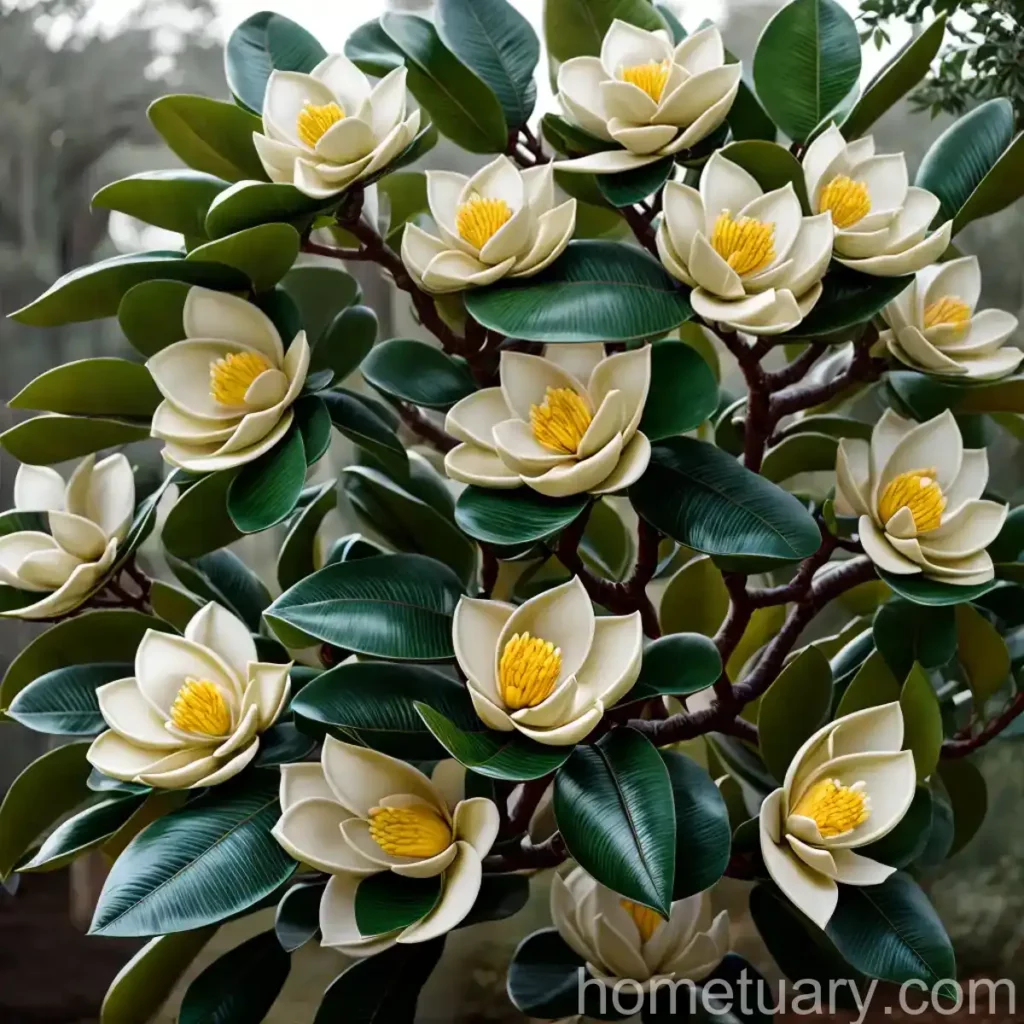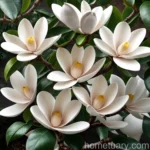Southern Magnolia (Magnolia grandiflora ‘D.D. Blanchard’)
Southern magnolia, scientifically known as Magnolia grandiflora ‘D.D. Blanchard’, is a magnificent evergreen tree that has been cherished for centuries for its stunning beauty and versatility in landscaping. Its lush foliage, fragrant flowers, and stately appearance make it a popular choice for gardens, parks, and urban landscapes. In this comprehensive guide, we will delve into the various aspects of this iconic plant, including its culture, uses, care requirements, common diseases and pests, as well as propagation and fun facts about this majestic tree.
Key Takeaways
- Scientific Name: Magnolia grandiflora ‘D.D. Blanchard’
- Common Name: Southern magnolia ‘D.D. Blanchard’
- Cultivar: Magnolia grandiflora cultivar
- Characteristics: Stately evergreen tree, fragrant flowers, lush foliage
- Uses: Ornamental, landscaping, shade tree
- Water: Regular watering, especially during the establishment phase
- Sunlight: Full to partial sunlight
- Fertilizer: Balanced fertilizer in spring
- Soil: Well-draining, acidic to slightly alkaline soil
- Pruning: Minimal pruning required, best done in late winter or early spring
- Propagation: Seeds, cuttings, or grafting
- Common Pests: Scale insects, aphids
- Common Diseases: Leaf spot, powdery mildew
- Fragrance: Pleasant lemon scent
- Hardiness Zone: 7-9
- Height: 60-80 feet
- Spread: 30-40 feet
- Growth Rate: Moderate
- Landscape Uses: Specimen tree, shade tree, focal point in landscaping
- Fun Fact: The Southern magnolia is the state tree of Mississippi and the state flower of both Mississippi and Louisiana.
Now, let’s explore the intricate details of caring for, cultivating, and enjoying the Southern magnolia in your outdoor space.
Culture
Uses
Southern magnolia is renowned for its ornamental and practical uses in various landscaping settings. Here are some common uses of this magnificent tree:
- Ornamental Tree: The Southern magnolia serves as a beautiful ornamental tree, adding a touch of elegance and grandeur to any landscape.
- Shade Tree: With its broad and dense canopy, it provides excellent shade, making it an ideal choice for outdoor relaxation areas.
- Focal Point: Its striking foliage, glossy leaves, and large, fragrant flowers make it an eye-catching focal point in any garden or park.
- Screening: Due to its dense foliage, it can be used as a natural screen or privacy barrier to enhance seclusion in outdoor spaces.
- Wildlife Habitat: The Southern magnolia attracts various pollinators and birds, enriching the biodiversity of the surrounding area.
Care
Water
Proper watering is essential for the healthy growth and development of Southern magnolia trees, especially during the initial establishment phase. Here are some key points to consider regarding watering:
- Establishment: Newly planted Southern magnolias require regular watering to ensure that the root system establishes itself in the soil. Adequate moisture is crucial during the first year after planting.
- Mature Trees: Once established, Southern magnolias are relatively drought-tolerant, but they benefit from regular watering during dry spells, particularly in summer.
- Soil Moisture: The soil should be evenly moist but not waterlogged. It’s important to monitor the moisture levels to prevent both under-watering and over-watering, which can stress the tree.
Sunlight
Southern magnolias thrive in locations with adequate sunlight, though they can also tolerate partial shade. Here are some sunlight-related considerations:
- Full Sun: Ideally, these trees should be planted in a location that receives full sunlight for the majority of the day. This promotes optimal growth and prolific flowering.
- Partial Shade: While they prefer full sun, Southern magnolias can adapt to partial shade, particularly in hot climates or regions with intense afternoon sun.
Fertilizer
Applying the right type of fertilizer at the appropriate time can significantly benefit the overall health and vitality of Southern magnolia trees. Here are some fertilization tips:
- Balanced Fertilizer: Use a balanced, slow-release fertilizer formulated for trees and shrubs in early spring to support healthy growth and flowering.
- Application: Gently spread the fertilizer under the canopy of the tree, avoiding direct contact with the trunk, and water thoroughly to ensure proper absorption.
Soil
The soil composition and quality play a crucial role in the well-being of Southern magnolia trees. Consider the following soil recommendations:
- Acidic to Slightly Alkaline: Southern magnolias prefer well-draining soil that is slightly acidic to slightly alkaline. A pH range of 6.0 to 7.0 is generally suitable for optimal growth.
- Organic Matter: Amending the soil with organic matter, such as compost, can improve its structure and fertility, creating a more conducive environment for the tree’s roots.
Pruning
Southern magnolias typically require minimal pruning, mainly for aesthetic shaping, removing dead or damaged branches, and maintaining a balanced canopy. Here are some key considerations when it comes to pruning:
- Timing: Pruning is best done in late winter to early spring before the new growth emerges. This allows the tree to heal efficiently and minimizes stress on the tree.
- Pruning Technique: Use clean, sharp pruning tools to make precise cuts, and avoid excessive or aggressive pruning, as Southern magnolias are sensitive to extensive pruning.
Propagation
Propagating Southern magnolia can be achieved through various methods, including seeds, cuttings, and grafting. Each propagation method has its own set of requirements and challenges:
- Seeds: While Southern magnolia trees produce attractive seed cones, the seeds may take a considerable amount of time to germinate and establish. Patience is required when propagating through seeds.
- Cuttings: Softwood or semi-hardwood cuttings can be taken from the current season’s growth and rooted under controlled conditions to produce new plants.
- Grafting: This method involves joining a scion (desired cultivar) with a suitable rootstock to create a grafted tree with the desired characteristics and traits.
Container Popularity
While Southern magnolias are typically known for their grand presence in the landscape, they can also be grown in containers, particularly in urban or confined spaces. The following points highlight the container-friendly aspects of Southern magnolias:
- Urban Gardens: The compact nature of container-grown Southern magnolias makes them a suitable choice for urban gardens, patios, and balconies where space is limited.
- Portability: Container-grown Southern magnolias can be shifted to different locations based on sunlight and temperature requirements, providing greater flexibility for the gardener.
- Aesthetic Appeal: These trees make stunning container specimens, adding a touch of sophistication to outdoor spaces and paving the way for creative landscaping possibilities.
Common Diseases
Despite its strength and resilience, the Southern magnolia is susceptible to certain diseases that can impact its overall health and appearance. Some common diseases to watch out for include:
- Leaf Spot: This fungal disease manifests as dark spots on the leaves, leading to premature leaf drop and defoliation if left untreated.
- Powdery Mildew: Characterized by a white, powdery coating on the foliage, powdery mildew can hinder photosynthesis and weaken the tree over time if not addressed promptly.
Disease Diagnosis
Proper diagnosis and identification of diseases affecting Southern magnolia trees are crucial for implementing effective treatment strategies. When observing potential disease symptoms, consider the following diagnostic measures:
- Visual Inspection: Carefully examine the foliage, stems, and trunk for any signs of discoloration, spots, or unusual growth patterns.
- Professional Consultation: If in doubt, consult with a plant pathologist or arborist to accurately diagnose the specific disease and receive tailored treatment recommendations.
Common Pests
Like many plants, Southern magnolias can fall victim to certain insect pests that may compromise their health and vigor. Some of the common pests include:
- Scale Insects: These sap-sucking pests can infest the leaves and stems, leading to stunted growth and reduced vitality if the infestation is severe.
- Aphids: These tiny, soft-bodied insects can cluster on the undersides of leaves, causing distortion of new growth and transmitting viral diseases in some cases.
Botanist’s Tips
To ensure the optimal health and longevity of Southern magnolia trees, consider these expert tips from botanists and horticulturists:
- Regular Monitoring: Keep a close eye on the tree for any signs of stress, disease, or pest infestations, and address any issues promptly to prevent escalation.
- Mulching: Apply a layer of organic mulch around the base of the tree to conserve moisture, regulate soil temperature, and reduce competition from weeds.
- Protection: In regions with harsh winters, provide protection for young trees by wrapping the trunks with tree guards or burlap to prevent damage from freezing temperatures.
Fun Facts
- The Southern magnolia is named after the French botanist Pierre Magnol and is native to the southeastern United States.
- In addition to its beauty, the Southern magnolia has served practical purposes historically, with its wood being used for furniture, veneer, and musical instruments.
- The large, waxy flowers of the Southern magnolia are not only visually captivating but also emit a delightful lemon fragrance, further enhancing their appeal.
Links to External Resources
Here are some reliable external resources where you can find further information about Southern magnolias:
- The American Magnolia Society: A comprehensive source of information on magnolias, including cultivation tips and upcoming events.
- University of Florida IFAS Extension: Provides detailed guides on the cultivation, care, and common issues affecting magnolia trees.
- Mississippi State University Extension Service: Offers research-based publications and resources on growing and maintaining Southern magnolia trees.
- The Morton Arboretum: Features a detailed description of the Southern magnolia, highlighting its ornamental and ecological attributes.
In conclusion, the Southern magnolia (Magnolia grandiflora ‘D.D. Blanchard’) stands as a timeless symbol of beauty and resilience in the realm of ornamental trees. Its striking appearance, fragrant blooms, and versatile nature make it a cherished addition to diverse landscapes, from sprawling gardens to urban spaces. By following the recommended cultivation and care practices, you can savor the magnificence of this majestic tree and create an enduring natural masterpiece in your outdoor environment.
Keywords: Magnolia grandiflora ‘D.D. Blanchard’, Southern magnolia ‘D.D. Blanchard’, Magnolia grandiflora cultivar, D.D. Blanchard Southern magnolia, Magnolia D.D. Blanchard hybrid, Magnolia grandiflora variety, Southern magnolia tree, D.D. Blanchard magnolia characteristics, Magnolia grandiflora ‘D.D. Blanchard’ features, Southern magnolia ‘D.D. Blanchard’ care, Best practices for growing D.D. Blanchard magnolia, Southern magnolia ‘D.D. Blanchard’ pruning tips, Magnolia grandiflora ‘D.D. Blanchard’ landscaping ideas, D.D. Blanchard Southern magnolia pests and diseases, Magnolia grandiflora ‘D.D. Blanchard’ foliar problems, Southern magnolia ‘D.D. Blanchard’ root system, Soil requirements for D.D. Blanchard magnolia, Magnolia grandiflora ‘D.D. Blanchard’ hardiness zone, D.D. Blanchard Southern magnolia propagation methods, Magnolia grandiflora ‘D.D. Blanchard’ flowering season, Southern magnolia ‘D.D. Blanchard’ leaf characteristics, D.D. Blanchard magnolia bark texture, Magnolia grandiflora ‘D.D. Blanchard’ growth rate, Southern magnolia ‘D.D. Blanchard’ landscape design, D.D. Blanchard magnolia as a shade tree, Magnolia grandiflora ‘D.D. Blanchard’ winter care, Southern magnolia ‘D.D. Blanchard’ pollination requirements, D.D. Blanchard magnolia pruning schedule, Magnolia grandiflora ‘D.D. Blanchard’ water requirements, Southern magnolia ‘D.D. Blanchard’ sunlight preferences, D.D. Blanchard Southern magnolia companion plants, Magnolia grandiflora ‘D.D. Blanchard’ container gardening, Southern magnolia ‘D.D. Blanchard’ landscape focal point, D.D. Blanchard magnolia for urban gardens, Magnolia grandiflora ‘D.D. Blanchard’ fragrance, Southern magnolia ‘D.D. Blanchard’ natural habitat, D.D. Blanchard magnolia fall color, Magnolia grandiflora ‘D.D. Blanchard’ wildlife attraction, Southern magnolia ‘D.D. Blanchard’ seed production, D.D. Blanchard magnolia as a windbreak, Magnolia grandiflora ‘D.D. Blanchard’ privacy screen, Southern magnolia ‘D.D. Blanchard’ landscape uses, D.D. Blanchard magnolia for coastal regions, Magnolia grandiflora ‘D.D. Blanchard’ allergies, Southern magnolia ‘D.D. Blanchard’ medicinal uses, D.D. Blanchard magnolia as a specimen tree, Magnolia grandiflora ‘D.D. Blanchard’ leaf drop, Southern magnolia ‘D.D. Blanchard’ drought tolerance, D.D. Blanchard magnolia as a centerpiece, Magnolia grandiflora ‘D.D. Blanchard’ leaf spot resistance















